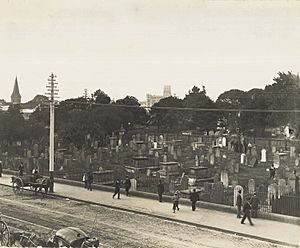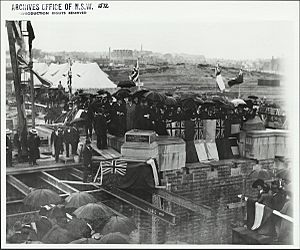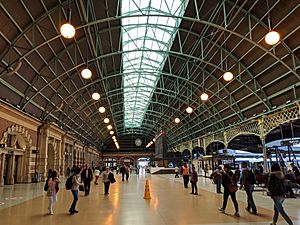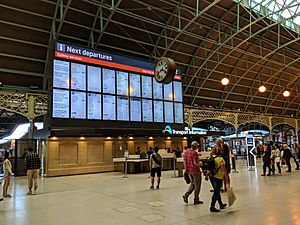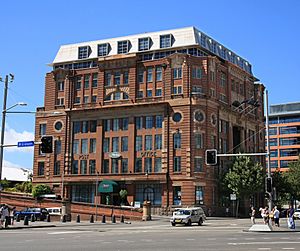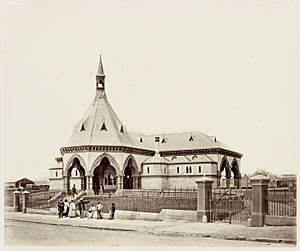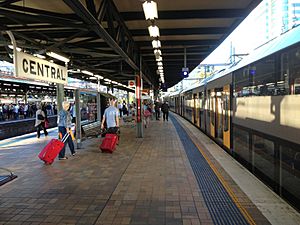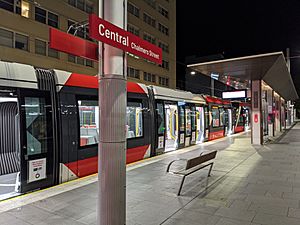Central railway station, Sydney facts for kids
Quick facts for kids
Central
|
|||||||||||||||||||||||||||||||||||||||||||||||||||||||||||||||||||||||||||||||||||||||||||||||||||||||||||||||||||||||||||||||||
|---|---|---|---|---|---|---|---|---|---|---|---|---|---|---|---|---|---|---|---|---|---|---|---|---|---|---|---|---|---|---|---|---|---|---|---|---|---|---|---|---|---|---|---|---|---|---|---|---|---|---|---|---|---|---|---|---|---|---|---|---|---|---|---|---|---|---|---|---|---|---|---|---|---|---|---|---|---|---|---|---|---|---|---|---|---|---|---|---|---|---|---|---|---|---|---|---|---|---|---|---|---|---|---|---|---|---|---|---|---|---|---|---|---|---|---|---|---|---|---|---|---|---|---|---|---|---|---|---|---|

Central railway station, pictured in 2017
|
|||||||||||||||||||||||||||||||||||||||||||||||||||||||||||||||||||||||||||||||||||||||||||||||||||||||||||||||||||||||||||||||||
| Location | Eddy Avenue, Sydney, New South Wales Australia |
||||||||||||||||||||||||||||||||||||||||||||||||||||||||||||||||||||||||||||||||||||||||||||||||||||||||||||||||||||||||||||||||
| Coordinates | 33°53′06″S 151°12′19″E / 33.8849°S 151.2052°E | ||||||||||||||||||||||||||||||||||||||||||||||||||||||||||||||||||||||||||||||||||||||||||||||||||||||||||||||||||||||||||||||||
| Elevation | 20 metres (67 ft) | ||||||||||||||||||||||||||||||||||||||||||||||||||||||||||||||||||||||||||||||||||||||||||||||||||||||||||||||||||||||||||||||||
| Owned by | Transport Asset Holding Entity | ||||||||||||||||||||||||||||||||||||||||||||||||||||||||||||||||||||||||||||||||||||||||||||||||||||||||||||||||||||||||||||||||
| Platforms | 25
|
||||||||||||||||||||||||||||||||||||||||||||||||||||||||||||||||||||||||||||||||||||||||||||||||||||||||||||||||||||||||||||||||
| Train operators |
|
||||||||||||||||||||||||||||||||||||||||||||||||||||||||||||||||||||||||||||||||||||||||||||||||||||||||||||||||||||||||||||||||
| Connections |
|
||||||||||||||||||||||||||||||||||||||||||||||||||||||||||||||||||||||||||||||||||||||||||||||||||||||||||||||||||||||||||||||||
| Construction | |||||||||||||||||||||||||||||||||||||||||||||||||||||||||||||||||||||||||||||||||||||||||||||||||||||||||||||||||||||||||||||||||
| Structure type | Ground & underground | ||||||||||||||||||||||||||||||||||||||||||||||||||||||||||||||||||||||||||||||||||||||||||||||||||||||||||||||||||||||||||||||||
| Disabled access | Yes | ||||||||||||||||||||||||||||||||||||||||||||||||||||||||||||||||||||||||||||||||||||||||||||||||||||||||||||||||||||||||||||||||
| Other information | |||||||||||||||||||||||||||||||||||||||||||||||||||||||||||||||||||||||||||||||||||||||||||||||||||||||||||||||||||||||||||||||||
| Status | Staffed (24 hours, 7 days/week) | ||||||||||||||||||||||||||||||||||||||||||||||||||||||||||||||||||||||||||||||||||||||||||||||||||||||||||||||||||||||||||||||||
| Website | Central station at TransportNSW info | ||||||||||||||||||||||||||||||||||||||||||||||||||||||||||||||||||||||||||||||||||||||||||||||||||||||||||||||||||||||||||||||||
| History | |||||||||||||||||||||||||||||||||||||||||||||||||||||||||||||||||||||||||||||||||||||||||||||||||||||||||||||||||||||||||||||||||
| Opened | 5 August 1906 | ||||||||||||||||||||||||||||||||||||||||||||||||||||||||||||||||||||||||||||||||||||||||||||||||||||||||||||||||||||||||||||||||
| Electrified | Yes | ||||||||||||||||||||||||||||||||||||||||||||||||||||||||||||||||||||||||||||||||||||||||||||||||||||||||||||||||||||||||||||||||
| Traffic | |||||||||||||||||||||||||||||||||||||||||||||||||||||||||||||||||||||||||||||||||||||||||||||||||||||||||||||||||||||||||||||||||
| Passengers (2018) | 85.4 million 233,970 (daily) |
||||||||||||||||||||||||||||||||||||||||||||||||||||||||||||||||||||||||||||||||||||||||||||||||||||||||||||||||||||||||||||||||
| Rank | 1 | ||||||||||||||||||||||||||||||||||||||||||||||||||||||||||||||||||||||||||||||||||||||||||||||||||||||||||||||||||||||||||||||||
|
|||||||||||||||||||||||||||||||||||||||||||||||||||||||||||||||||||||||||||||||||||||||||||||||||||||||||||||||||||||||||||||||||
|
Building details
|
|||||||||||||||||||||||||||||||||||||||||||||||||||||||||||||||||||||||||||||||||||||||||||||||||||||||||||||||||||||||||||||||||
| General information | |||||||||||||||||||||||||||||||||||||||||||||||||||||||||||||||||||||||||||||||||||||||||||||||||||||||||||||||||||||||||||||||||
| Status | Complete | ||||||||||||||||||||||||||||||||||||||||||||||||||||||||||||||||||||||||||||||||||||||||||||||||||||||||||||||||||||||||||||||||
| Type | Railway station terminus | ||||||||||||||||||||||||||||||||||||||||||||||||||||||||||||||||||||||||||||||||||||||||||||||||||||||||||||||||||||||||||||||||
| Architectural style | Federation Free Classical | ||||||||||||||||||||||||||||||||||||||||||||||||||||||||||||||||||||||||||||||||||||||||||||||||||||||||||||||||||||||||||||||||
| Completed | 1906 | ||||||||||||||||||||||||||||||||||||||||||||||||||||||||||||||||||||||||||||||||||||||||||||||||||||||||||||||||||||||||||||||||
| Inaugurated | 4 August 1906 | ||||||||||||||||||||||||||||||||||||||||||||||||||||||||||||||||||||||||||||||||||||||||||||||||||||||||||||||||||||||||||||||||
| Renovated | 1979 January 1915 | ||||||||||||||||||||||||||||||||||||||||||||||||||||||||||||||||||||||||||||||||||||||||||||||||||||||||||||||||||||||||||||||||
| Client | New South Wales Government Railways | ||||||||||||||||||||||||||||||||||||||||||||||||||||||||||||||||||||||||||||||||||||||||||||||||||||||||||||||||||||||||||||||||
| Height | |||||||||||||||||||||||||||||||||||||||||||||||||||||||||||||||||||||||||||||||||||||||||||||||||||||||||||||||||||||||||||||||||
| Tip | 85.6 metres (281 ft) AHD | ||||||||||||||||||||||||||||||||||||||||||||||||||||||||||||||||||||||||||||||||||||||||||||||||||||||||||||||||||||||||||||||||
| Technical details | |||||||||||||||||||||||||||||||||||||||||||||||||||||||||||||||||||||||||||||||||||||||||||||||||||||||||||||||||||||||||||||||||
| Material |
|
||||||||||||||||||||||||||||||||||||||||||||||||||||||||||||||||||||||||||||||||||||||||||||||||||||||||||||||||||||||||||||||||
| Design and construction | |||||||||||||||||||||||||||||||||||||||||||||||||||||||||||||||||||||||||||||||||||||||||||||||||||||||||||||||||||||||||||||||||
| Architect | Walter Liberty Vernon (1901-06) | ||||||||||||||||||||||||||||||||||||||||||||||||||||||||||||||||||||||||||||||||||||||||||||||||||||||||||||||||||||||||||||||||
| Architecture firm | New South Wales Government Architect | ||||||||||||||||||||||||||||||||||||||||||||||||||||||||||||||||||||||||||||||||||||||||||||||||||||||||||||||||||||||||||||||||
| Developer | Government of New South Wales | ||||||||||||||||||||||||||||||||||||||||||||||||||||||||||||||||||||||||||||||||||||||||||||||||||||||||||||||||||||||||||||||||
| Engineer | Henry Deane (Engineer in Chief of the New South Wales Government Railways) | ||||||||||||||||||||||||||||||||||||||||||||||||||||||||||||||||||||||||||||||||||||||||||||||||||||||||||||||||||||||||||||||||
| Services engineer | John Bradfield (rail engineering) | ||||||||||||||||||||||||||||||||||||||||||||||||||||||||||||||||||||||||||||||||||||||||||||||||||||||||||||||||||||||||||||||||
| Other designers | Fairfax & Roberts (clock tower) | ||||||||||||||||||||||||||||||||||||||||||||||||||||||||||||||||||||||||||||||||||||||||||||||||||||||||||||||||||||||||||||||||
| Main contractor | NSW Department of Public Works | ||||||||||||||||||||||||||||||||||||||||||||||||||||||||||||||||||||||||||||||||||||||||||||||||||||||||||||||||||||||||||||||||
| Official name | Sydney Terminal and Central Railway Stations Group; Central Railway; Central Station; Underbridges | ||||||||||||||||||||||||||||||||||||||||||||||||||||||||||||||||||||||||||||||||||||||||||||||||||||||||||||||||||||||||||||||||
| Type | State heritage (complex / group) | ||||||||||||||||||||||||||||||||||||||||||||||||||||||||||||||||||||||||||||||||||||||||||||||||||||||||||||||||||||||||||||||||
| Criteria | a., b., c., d., e., f., g. | ||||||||||||||||||||||||||||||||||||||||||||||||||||||||||||||||||||||||||||||||||||||||||||||||||||||||||||||||||||||||||||||||
| Designated | 2 April 1999 | ||||||||||||||||||||||||||||||||||||||||||||||||||||||||||||||||||||||||||||||||||||||||||||||||||||||||||||||||||||||||||||||||
| Reference no. | 1255 | ||||||||||||||||||||||||||||||||||||||||||||||||||||||||||||||||||||||||||||||||||||||||||||||||||||||||||||||||||||||||||||||||
| Type | Railway Platform/ Station | ||||||||||||||||||||||||||||||||||||||||||||||||||||||||||||||||||||||||||||||||||||||||||||||||||||||||||||||||||||||||||||||||
| Category | Transport - Rail | ||||||||||||||||||||||||||||||||||||||||||||||||||||||||||||||||||||||||||||||||||||||||||||||||||||||||||||||||||||||||||||||||
Central Station is a very old and important train station in Sydney, New South Wales. It's the biggest and busiest train station in the whole state! Think of it as a giant meeting point for all kinds of transport. You can catch NSW TrainLink trains that go to other cities, Sydney Trains for local trips, and even light rail and buses. It's also sometimes called Sydney Terminal, especially the older part where longer-distance trains arrive. In 2018, over 85 million people passed through Central Station!
Central Station is huge, taking up a whole city block. It sits between areas like Haymarket, Surry Hills, and the main city centre. It's bordered by Railway Square on one side and Elizabeth Street on the other. Did you know that parts of the station are built on what used to be a cemetery?
Contents
History of Central Station
Sydney has had three main train stations over time. The first two were in a slightly different spot, and the third one is the Central Station we know today.
Early Sydney Train Stations
The first train line in New South Wales opened in 1855, connecting Sydney and Parramatta. The very first Sydney station was a simple building made of timber and iron. It opened on 26 September 1855. This station was often called "Redfern station" by people, even though it wasn't actually in Redfern.
As more people started using trains, a bigger station was needed. So, in 1874, a new brick station was built on the same spot. It had two platforms at first, but grew to 14 platforms over time. This second station was also called Sydney Terminal.
Building the Current Central Station
People wanted the train station to be closer to the city centre. After a lot of planning, it was decided to build the new station one block north of the old one. This new location was where the Devonshire Street Cemetery used to be. All the remains from the cemetery were carefully moved to other cemeteries like Rookwood and Waverley.
The current Central Station was designed by a government architect named Walter Liberty Vernon. It officially opened on 4 August 1906. The station was built with beautiful Sydney sandstone. It was designed to be grand and important, showing how vital the railways were to the state.
An 85.6-metre-tall (281 ft) clock tower was added to the station in 1921. It's a famous landmark that you can see from far away.
How the Station Changed Over Time
Central Station started with 11 platforms and quickly grew to 19. In the 1920s, the station was updated to handle electric trains. New platforms were added on the eastern side, and the existing ones were also wired for electricity. This was a big project that included building tunnels and even the Sydney Harbour Bridge.
Later, in 1979, two more underground platforms were added as part of the Eastern Suburbs railway line. These were planned for future use and are not currently in service.
The "Battle of Central Station"
In 1916, there was an incident at Central Station. Soldiers who were unhappy with their camp conditions came to the city by train. When they arrived, there was a disturbance at the station. One person was shot, and several were hurt. This event led to a change in laws about when hotels could close in New South Wales. You can still see a small bullet hole in the marble near the entrance to Platform 1.
Modern Updates
Central Station has been updated many times over the years to make it better for passengers. In 1980, a big modernization program started to improve the facilities. More recently, in 2018, construction began to build two new underground platforms for the Sydney Metro City & Southwest line, and a new underground area called Central Walk.
Station Layout and Features
Central Station is a huge complex with different parts. The main building is on the northern side, and behind it are large train yards.
Sydney Terminal Building
The main part of Central Station is the grand sandstone building from 1906. It's called the "Sydney Terminal Building" by railway staff. It's designed to look impressive and show how important the railways are.
The main area inside, called the "Main Assembly platform" or Grand Concourse, is where passengers gather. It has a high, vaulted roof and is made of beautiful sandstone. This area is elevated, meaning it's higher than the surrounding roads. This design helped separate different types of transport, like trams and cars, and allowed for an underground luggage system.
The station has 15 platforms that end at the main building. These are mostly used for longer-distance trains like NSW TrainLink services and the famous Indian Pacific train. Platforms 1 to 3 are usually for country and interstate services.
Central Electric Station
To the east of the main building are ten more platforms. These are used by local Sydney Trains services and some intercity trains during busy times. This part of the station is sometimes called the "Central Electric Station" or "suburban" platforms. It was built in the 1920s when electric trains became common.
These platforms are also elevated and connect to tunnels that lead to the City Circle underground rail system and across the Sydney Harbour Bridge.
Metro Station
Currently, new underground platforms are being built beneath Platforms 13-14. These will be for the new Sydney Metro City & Southwest line, which is expected to open in the future.
Indicator Board
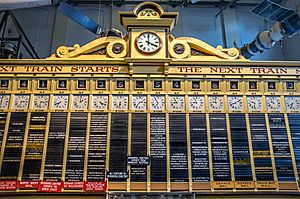
When Central Station first opened, it had a large indicator board to show train times. This old board is now on display at the Powerhouse Museum. In 2015, a new, modern indicator board was installed in the main concourse.
Devonshire Street Tunnel
When Central Station was built, the old Devonshire Street became an underpass. This is now known as the Devonshire Street Tunnel or Subway. It's a pedestrian walkway that helps people get from Railway Square to the eastern side of the station. The tunnel also connects to The Goods Line, which is a park and walking path built on an old railway line.
Railway Square
On the western side of Central Station is Railway Square. This area has always been an important entry point to the city, especially for people arriving from the south and west. The tall clock tower of Central Station overlooks Railway Square, marking the time for arrivals and departures.
Mortuary Station
A unique building near Central Station is the Mortuary Station, also called the Receiving House. It was built in 1869 for funeral parties. Mourners would accompany coffins on a special train journey to the necropolis (a large cemetery) at Rookwood Cemetery.
The Mortuary Station was designed in a beautiful Gothic Revival style by James Barnet, the Colonial Architect. It has delicate stonework and carvings. It's very rare to find special stations built just for funerals like this one. Today, it's part of the Central Station complex, though it's separate from the main buildings. It was restored in 1983.
Railway Institute
The Railway Institute building on Chalmers Street was built in 1891. It was a place for railway employees to learn and socialize. It had classrooms, a library, and halls for events. It was one of the first railway institutes in Australia and provided many services for staff.
Platforms
Central Station has 25 platforms.
- Platforms 1 to 15 are above ground and are part of the main Sydney Terminal building. These are mostly for longer-distance trains.
- Platforms 16 to 23 are also above ground and are part of the suburban station on the eastern side. These are mainly for local Sydney Trains services.
- Platforms 24 to 25 are underground.
- New platforms are being built under Platforms 13 and 14 for the future metro line.
| Platform | Line | Stopping pattern | Notes |
| 1 to 3 |
North Coast Region
|
services to Grafton, Casino & Brisbane | Platforms 1 to 15 are terminal platforms |
|---|---|---|---|
|
North Western Region
|
services to Armidale & Moree | ||
|
Southern Region
|
services to Canberra, Griffith & Melbourne | ||
|
Western Region
|
services to Dubbo & Broken Hill | ||
| Indian Pacific | services to Perth | ||
| 4 to 12 |
CCN
|
services to Newcastle via Strathfield | |
|
BMT
|
services to Lithgow & Bathurst | ||
|
SCO
|
services to Kiama | ||
|
SHL
|
evening peak services to Moss Vale & Goulburn | ||
|
T7
|
special event services to Olympic Park | ||
| morning & evening peak hour services to Hornsby via Strathfield | |||
| 13 to 15 | closed | closed for construction of Sydney Metro underground platforms | |
| 16 | services to Berowra via Gordon | ||
| services to Gordon | |||
|
CCN
|
evening peak services to Newcastle via Gordon | ||
| 17 | services to the City Circle via Town Hall | ||
|
T3
|
services to the City Circle via Town Hall | ||
| 18 | services to Richmond & Emu Plains | ||
| services to Hornsby via Strathfield | |||
| 19 | services to Parramatta & Leppington | ||
| 20 |
T3
|
services to the City Circle via Museum | |
| 21 |
T8
|
services to the City Circle via Museum | |
| 22 |
T8
|
evening peak services to Macarthur via Sydenham | |
|
T3
|
services to Lidcombe & Liverpool via Bankstown | ||
| 23 |
T8
|
services to Revesby, & Macarthur via the Airport | |
| 24 |
T4
|
services to Bondi Junction | |
|
SCO
|
services to Bondi Junction | ||
| 25 |
T4
|
services to Cronulla & Waterfall | |
|
SCO
|
services to Port Kembla & Kiama | ||
| 26 & 27 | Never completed | used only for archival document storage | |
| Never completed | used only for archival document storage |
Connecting Services
Central Station is a major transport hub, meaning you can connect to many other types of transport here.
Light Rail
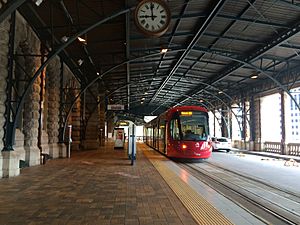
The Dulwich Hill Line starts at Central Grand Concourse. This light rail service takes you to places like Chinatown, Darling Harbour, and inner western suburbs. This area was originally designed for trams and was used by them until 1958.
The CBD and South East Light Rail also runs near Central, with stops at Haymarket and Central Chalmers Street.
Bus Services
Many bus services leave from Eddy Avenue, Elizabeth Street, or Railway Square, right next to the station.
Coach Services
Long-distance coaches (buses) also depart from Central Station, taking you to other cities and towns in Australia. Some of the companies include:
- Australia Wide Coaches (to Orange)
- Firefly Express (to Melbourne and Adelaide)
- Greyhound Australia (to Brisbane, Byron Bay, Canberra, and Melbourne)
- Murrays (to Canberra)
- Port Stephens Coaches (to Fingal Bay)
- Premier Motor Service (to Brisbane and Eden)
Heritage Listing
Central Station is a very important historical site in New South Wales. It's listed on the New South Wales State Heritage Register because of its historical significance, beautiful design, and importance to the community. This listing includes the main Sydney Terminal building, the train yards, the Mortuary Station, the old Darling Harbour branch line, the Railway Institute, and the Parcel Post Office.
Diagrams and Maps
Images for kids
-
The station viewed from Belmore Park, 1924
-
The Railway Institute Building on Chalmers Street


